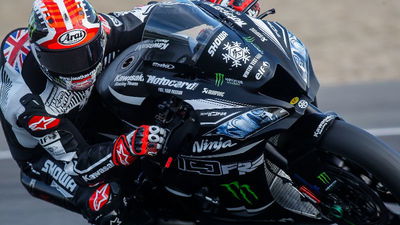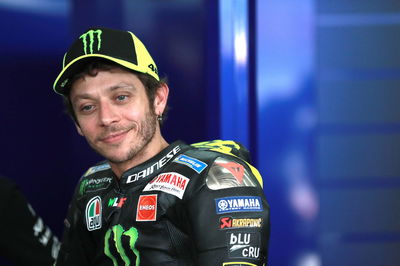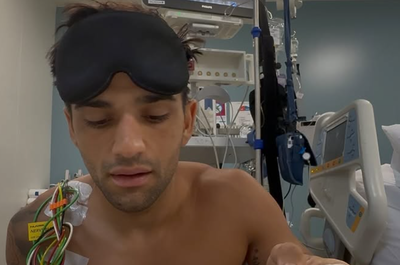Kawasaki and the 'strange' MotoGP wild-card request
Last month, Dorna CEO Carmelo Ezpeleta revealed the surprising news that "Kawasaki asked me about the possibility of doing [MotoGP] wild-cards with their Superbike."
It had apparently been made via the Provec team, which manages the reigning title-winning factory Kawasaki WorldSBK squad from its base at Granollers, in Catalunya.

Last month, Dorna CEO Carmelo Ezpeleta revealed the surprising news that "Kawasaki asked me about the possibility of doing [MotoGP] wild-cards with their Superbike."
It had apparently been made via the Provec team, which manages the reigning title-winning factory Kawasaki WorldSBK squad from its base at Granollers, in Catalunya.
Kawasaki quit MotoGP under something of a cloud following the 2008 financial crisis, reluctantly running an unbranded ('Hayate') single bike for Marco Melandri the following year before putting all its efforts into WorldSBK, where the ZX-10R has won the title for six of the last seven seasons with Rea (5) and Tom Sykes (1).
Ezpeleta later 'clarified' that Kawasaki had not made an "official" wild-card request, suggesting the approach was more about exploring the possibilities.
Whatever the motive, a Kawasaki-backed wild-card would be surprising on several levels.
Firstly, because Kawasaki is not known to be interested in a return to MotoGP and secondly because, according to Ezpeleta, the intention had been to do it with a ZX-10R Superbike.
That naturally suggested reigning WorldSBK champion Jonathan Rea would be on-board.
Maybe the Ulsterman was eager to prove a point after his five SBK titles had apparently failed to raise a concrete factory-MotoGP offer?
Instead, Rea was as surprised as anyone:
"I didn't really understand that [wild-card request]. It's strange," the 33-year-old is quoted as saying by Speedweek.com. "I don't want a wild-card in MotoGP with my Kawasaki! It could be funny, but it's a joke.
"I would compete against prototype bikes with prototype tyres on a street motorcycle that was developed for Pirelli tyres. It would be like driving a touring car against a Formula 1 car.
"We are a championship based on production bikes. Superbike and MotoGP are different worlds. It's like comparing apples to pears."
As well as the huge performance disadvantages highlighted by Rea, especially on a bike designed for Pirelli rather than Michelin tyres, a WorldSBK machine would not even be legal for use in MotoGP.
Ezpeleta said it couldn't happen simply because "wild-cards are only possible for existing [MotoGP] manufacturers".
However, the MotoGP rules do refer to wild-card entries "using machines from a manufacturer not currently entered in the MotoGP class" adding these "are not subject to the regulations covering ECU hardware and software, dataloggers, sensors and free devices."
But the biggest obstacle to swapping Pirelli tyres for Michelins and entering a WorldSBK machine in MotoGP comes from the very opening line of the technical regulations:
"Motorcycles participating in the MotoGP class must be prototypes."
The exact definition of a prototype might be up for some debate, but it is hard to believe that in the context of the MotoGP rules a tuned Superbike could pass as a prototype.
Exactly what parts need to be changed to convert a production bike to a prototype was a debate that raged during the 'CRT' era.
While the current MotoGP engine rules avoid the word 'prototype', stating only: "Up to 1000cc. 4-stroke only, maximum 4 cylinders, maximum cylinder bore 81 mm", most other parts cannot come from a 'non-prototype':
"The chassis must be a prototype… The main frame, swingarm, fuel tank, seat and fairing/bodywork from a non-prototype (ie. series production road-homologated) motorcycle may not be used."
Which makes the Kawasaki/Provec wild-card talk all the more 'strange'.
If the question did indeed come from the team rather than Kawasaki, is the Spanish squad considering building a ZX-10R-powered prototype of its own? Might that eventually become the basis for an official Kawasaki MotoGP return?
But Ezpeleta was clear that no further MotoGP grid places will be added for manufacturers not currently in the premier-class and so Kawasaki can only return if they reach an agreement to take over an existing independent team.
MotoGP boasts factory teams from Honda, Ducati, Yamaha, Suzuki, KTM and Aprilia. Ducati also supports two satellite squads (Pramac and Avintia) with one independent entry backed by Honda (LCR), Yamaha (Sepang) and KTM (Tech3).
Aprilia is currently partnered with Gresini - the template outlined by Ezpeleta for a future manufacturer to enter the premier-class - but is expected to be granted its own places from 2022, meaning six constructors and six satellite teams.
Kawasaki in MotoGP: 2002 - 2008
2002 Pacific Grand Prix: The ZX-RR makes its MotoGP debut towards end of the 2002 season, in the hands of Kawasaki's WorldSBK race winner Akira Yanagawa, on home ground at Motegi. Yanagawa qualifies the angular-looking machine 18th out of the 22 riders, but crashes out of the race after an engine failure, sustaining a broken pelvis in the process.
2002 Malaysian Grand Prix: The injured Yanagawa is replaced by Kawasaki's former World Supersport champion Andrew Pitt for the remaining three rounds of the season, starting at Sepang in Malaysia, where Pitt takes the ZX-RR to its first MotoGP finish (albeit 19th and last).
2002 Valencian Grand Prix: Pitt scores the ZX-RR's first MotoGP points by claiming twelfth (out of 14 finishers) in the Valencia season finale.
2003 Japanese Grand Prix: The ZX-RR's first full season of racing starts at Suzuka, Japan, with a full two-rider line-up of Pitt and former 500cc race winner Garry McCoy.
2003 French Grand Prix: McCoy scores his first ZX-RR points, and claims Kawasaki's best finish of the season, with ninth place in a wet French Grand Prix at Le Mans (round four). McCoy scores points on only two further occasions.
2003 Valencian Grand Prix: McCoy finishes the season 22nd in the world championship, with 11 points, with Pitt 26th and last on just 4 points. Test and development rider Alex Hofmann impresses by being top Team Green rider in wild-card appearances at Mugello and Assen. Both McCoy and Pitt leave Kawasaki after the Valencia finale. Kawasaki finishes seventh and last in the constructors' championship (19 points) and 12th and last in the teams' championship (15 points).
2004 South African Grand Prix: New season begins with Hofmann promoted to a full-time race seat alongside former 250cc world championship runner-up and 500cc podium finisher Shinya Nakano. Kawasaki also changes from Dunlop to Bridgestone tyres.
2004 Italian Grand Prix: Nakano miraculously escapes serious injury when his rear tyre explodes at 300km/h (186mph) during the Italian GP at Mugello. Shinya is back in action just a week later at Catalunya, where he claims the ZX-RR's best race result to date with a seventh place finish.
2004 Pacific Grand Prix: Nakano takes the ZX-RR to its first ever MotoGP podium finish; third position on home ground at Motegi (round 12).
2004 Malaysian Grand Prix: Nakano qualifies third on the grid at Sepang for the ZX-RR's first front-row start. Finishes eighth in the race.
2004 Valencian Grand Prix: Nakano finishes the season tenth in the world championship with 83 points and only four non-scores, while Hofmann collects 51 points for 15th position. Kawasaki also takes fourth in the constructors' championship (95 points) and seventh in the teams' championship (134 points).
2005 Spanish Grand Prix: Nakano and Hofmann both retained for 2005 and start the year with fifth and eleventh places at the Jerez opener. For Nakano, it is his best result of the season.
2005 Portuguese Grand Prix: Hofmann highsides during a demonstration ride to promote the Portuguese GP (round two) breaking his left scaphoid and forcing him to miss both Estoril and the next two rounds.
2005 Chinese Grand Prix: Injured Hofmann replaced for round three by Olivier Jacque, who promptly stuns by finishing in second position - just 1.7sec behind Valentino Rossi - on his ZX-RR debut in soaking wet conditions at Shanghai. That result remains the joint best for a ZX-RR rider and the closest that a ZX-RR has come to victory.
2005 Valencia Grand Prix: 2005 ends with Nakano retaining tenth in the championship with a Team Green best of 98 points, despite no podiums, while Hofmann finishes 19th. Kawasaki holds fourth in the constructors' championship (126 points) and rises to sixth in the teams' championship during what was, on paper, its best MotoGP season.
2006 Spanish Grand Prix: Kawasaki raises eyebrows by 'reluctantly' dropping Hofmann in favour of rookie Randy de Puniet for the 2006 season, while Nakano remains for a third and final season. Nakano starts the year in style at Jerez with his first front row qualifying performance since Sepang 2004, but finishes seventh in the race. de Puniet doesn't reach the flag.
2006 Dutch TT: Nakano scores his second (and final) ZX-RR podium, and equals Kawasaki's best MotoGP result between 2002-2008, by finishing second at Assen in a race best remembered for a last turn showdown between Nicky Hayden and Colin Edwards.
2006 Australian Grand Prix: In addition to his third-place start at Jerez, Nakano illustrated his and the Bridgestone-shod ZX-RR's raw speed by qualifying second on the grid three-times during 2006, the last occasion being at Phillip Island.
October 2006: Kawasaki confirms that star rider Nakano will leave the team (for an ill-fated satellite Honda ride) at the end of the 2006 season.
2006 Valencian Grand Prix: Nakano's final season at Kawasaki ends with 14th in the world championship and 92 points, while de Puniet's first in MotoGP is marked by 16th position and 37 points. Kawasaki slips to sixth in the constructors' championship (109 points) and seventh in the teams' championship (129 points).
November 2006: Kawasaki splits from Harald Eckl, who had run its MotoGP team since 2002, claiming 'serious involvement with a competitor's MotoGP activities'. Kawasaki takes its restructured MotoGP race team 'in-house' for 2007 but the upheaval, combined with scepticism over the team's new 800cc machine, mean no top riders are interested and Jacque - who had been given a test and development role after his Shanghai success - finds himself promoted to a full-time race seat alongside de Puniet for 2007.
2007 Catalan Grand Prix: Despite its troubled 'birth', Kawasaki's first 800cc machine shows potential in the hands of de Puniet, who claims his first front row start at round seven in Catalunya. By contrast, Jacque suffers a difficult, accident littered, start to the season - scoring points in just one race - and steps back to the role of test and development rider after missing Catalunya due to injury.
2007 British Grand Prix: 250cc and World Supersport race winner Anthony West drafted in to replace Jacque from Donington Park onwards, where the Australian scores five points on his ZX-RR race debut.
July 2007: Competition manager Michael Bartholemy confirms that Kawasaki has signed John Hopkins for 2008 and 2009. Hopkins goes on to finish fourth in the 2007 world championship for Suzuki with four podium finishes.
2007 Japanese Grand Prix: de Puniet scores his first and only Kawasaki MotoGP podium with second place at round 15, Motegi. It marked the ZX-RR's fourth, and perhaps last, rostrum finish.
August 2007: With Hopkins confirmed, West and de Puniet look set to fight for the remaining 2008 seat, but de Puniet surprises the paddock - and Kawasaki - by signing for Honda LCR before any final decision about Hopper's team-mate is made. West is duly confirmed as staying at Kawasaki, alongside Hopkins, five days later.
2007 Valencian Grand Prix: de Puniet finishes eleventh in the world championship with 108 points while Kawasaki takes fifth in the constructors' championship (144 points) and seventh in the teams' championship. West scores points in all but one of his eleven starts, with a best of seventh.
January 2008: Kawasaki causes a stir by debuting a prototype 'screamer' engine during testing at Sepang, but it is never used in a grand prix. Indeed, Kawasaki opts not to introduce a new 2008 version of the ZX-RR, choosing instead to develop the 2007 model.
January 2008: Hopkins injured at Phillip Island test, forcing him to miss vital pre-season development.
2008 Portuguese Grand Prix: Hopkins finishes fifth during his third ZX-RR start. It would be his best result of the season and as a Kawasaki MotoGP rider.
2008 Catalan Grand Prix: Hopkins fractures vertebrae in Friday practice highside in Barcelona but returns to take tenth in the race.
2008 Dutch TT: Hopkins sustains leg fractures in 230km/h qualifying fall at Assen, forcing him to miss both the Dutch TT and next two rounds.
2008 Czech Republic Grand Prix: West scores MotoGP best of fifth at Brno, the highlight of an often miserable season in which he struggles with a chronic lack of rear traction.
September 2008: Kawasaki confirms signing of former MotoGP World Championship runner-up Marco Melandri to ride for Kawasaki in 2009 and 2010. "I'm confident that Marco will adapt quickly to Kawasaki's Ninja ZX-RR and that, together with John, he'll be able to take us to the next level with the development of the all-new 2009 bike," said Bartholemy. "What is certain is that, with Marco and John, we will go into 2009 with our strongest rider line-up since Kawasaki made their full-time return to the premier class in 2002."
October 2008: A deal for Jorge Martinez 'Aspar' to run a third ZX-RR in 2009 breaks down over rider choice; Aspar needs a Spaniard to please the sponsors lined up to back the project while Kawasaki wants Nakano to return.
2008 Valencian Grand Prix: What would prove to be the ZX-RR's final official season ends with Hopkins 16th in the championship and West 18th, out of 18 full-time riders. Kawasaki is fifth and last in the constructors' championship with just 88 points and is ninth out of ten in the teams' championship.
October/November 2008: Kawasaki takes part in post-season testing at Valencia and Phillip Island - during which Melandri makes a promising debut on the ZX-RR.
January 2009: Kawasaki announces 'suspension' of factory MotoGP activities for 2009 as a result of the worldwide financial crisis. Kawasaki is eventually persuaded to provide machinery and technical support to create an unofficial 'Hayate Racing Team', with Melandri as its lone rider. The Italian goes on to claim a podium at Le Mans and tenth overall in the world championship, despite no further development to the ZX-10R.
Kawasaki MotoGP results: 2002-2009
Wins: 0
Podiums: 5
Poles: 0
Front-row starts: 8
Fastest laps: 0
Highest riders' championship ranking: 10th (Nakano - '04, '05, Melandri '09)
Highest constructors' championship ranking: 4th ('04, '05)
Highest teams' championship ranking: 6th ('05)











